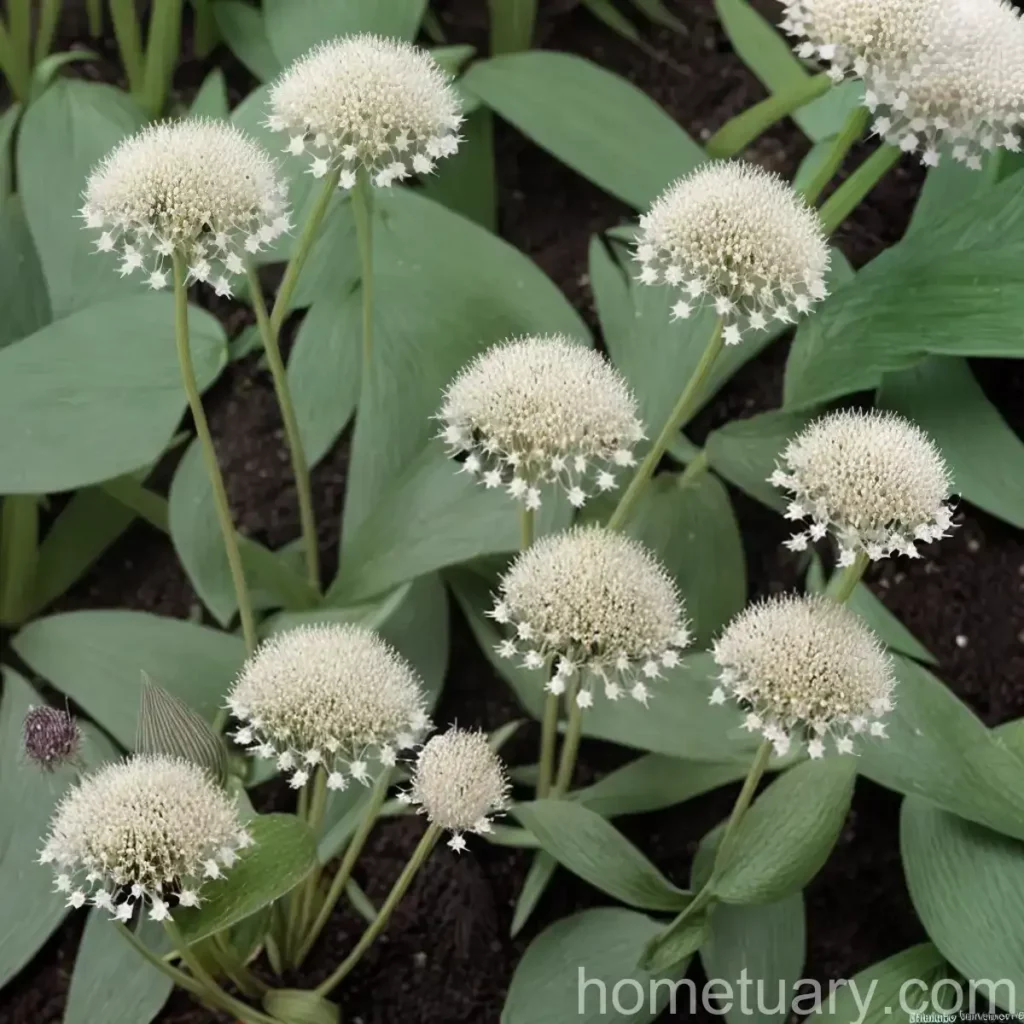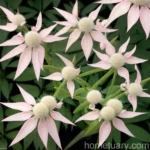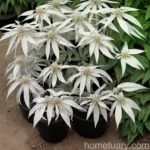Bugbane (Actaea simplex (Atropurpurea Group) ‘Brunette’)
Bugbane, scientifically known as Actaea simplex (Atropurpurea Group) ‘Brunette,’ is a striking perennial plant that is valued for its unique foliage and delicate flowers. This article explores the key characteristics, culture, uses, and maintenance of bugbane, as well as its popularity and common diseases. Whether you are an experienced gardener or just starting out, this comprehensive guide will provide you with all the information you need to cultivate and appreciate this fascinating plant.
What is Bugbane?
Bugbane, a member of the Ranunculaceae family, is a herbaceous perennial that is native to North America, Europe, and Asia. It is also commonly referred to as black cohosh, fairy candles, or snakeroot. The ‘Brunette’ variety, in particular, is cherished for its dramatic dark, almost black, foliage, which provides a stunning contrast in garden beds and borders.
The plant produces spiky, bottlebrush-like flowers on tall, wiry stems in late summer to early fall. These flowers are fragrant and attract pollinators, making bugbane a valuable addition to wildlife-friendly gardens. With its adaptability to shade and its low-maintenance nature, bugbane can thrive in various garden settings, from woodland landscapes to formal gardens.
Key Takeaways – Bugbane (Actaea simplex (Atropurpurea Group) ‘Brunette’)
- Botanical Name: Actaea simplex (Atropurpurea Group) ‘Brunette’
- Common Names: Bugbane, Black Cohosh, Fairy Candles, Snakeroot
- Foliage: Dark, almost black, foliage
- Flowers: Spiky, bottlebrush-like flowers in late summer to early fall
- Sunlight: Partial to full shade
- Soil Type: Moist, rich, well-draining soil
- Uses: Ornamental, wildlife garden, cut flowers
- Maintenance: Low maintenance, needs minimal pruning
Culture
Water
Bugbane thrives in consistently moist soil, making it well-suited for gardens with regular watering schedules. Although bugbane can tolerate periods of drought, it performs best when the soil is kept consistently moist. When grown in containers, it is essential to ensure adequate drainage to prevent waterlogging, which can lead to root rot.
Sunlight
Bugbane prefers partial to full shade, making it an excellent choice for shaded areas of the garden. It can tolerate some morning sun, especially in cooler climates, but it generally performs best in dappled or filtered shade. Placing bugbane in full sun can cause its dark foliage to scorch and diminish its overall vigor.
Soil
The ideal soil for bugbane is moist, rich, and well-draining. It thrives in humus-rich soils with a slightly acidic to neutral pH. Adding organic matter such as compost or well-rotted manure to the planting site can improve soil structure and fertility, creating an optimal growing environment for bugbane.
Fertilizer
Bugbane generally does not require heavy fertilization, especially if grown in nutrient-rich soil. However, applying a balanced, slow-release fertilizer in early spring can support healthy growth and flowering. It is essential to follow the manufacturer’s guidelines regarding application rates to avoid over-fertilizing, which can lead to excessive foliage at the expense of flowers.
Pruning
Bugbane typically requires minimal pruning, as its natural form and growth habit are part of its ornamental appeal. However, removing spent flower spikes after flowering can enhance the plant’s appearance and prevent self-seeding. Additionally, trimming back any damaged or yellowing foliage can promote fresh growth and maintain the plant’s visual appeal. Pruning is best done in early spring before new growth begins.
Propagation
Division
Bugbane can be propagated through division, typically performed in early spring before new growth emerges or in early fall. To propagate bugbane by division, carefully lift the plant from the ground and use a sharp, clean knife or garden spade to separate the rhizomes, ensuring that each division contains healthy roots and shoots. Replant the divisions at the same depth as the original plant, water thoroughly, and provide appropriate care as they establish themselves.
Seeds
Bugbane also produces seeds that can be collected and sown to propagate new plants. Collect the seeds when they are fully mature, typically in late summer to early fall. Sow the seeds in a prepared seedbed or containers with well-draining, sterile potting mix. Keep the soil consistently moist and place the containers in a shaded area. Once the seedlings have developed several sets of true leaves, they can be transplanted to their permanent growing positions.
Container Popularity
Bugbane is gaining popularity as a container plant due to its striking foliage and adaptability to shady conditions. When grown in a container, bugbane can serve as a focal point on patios, decks, or balconies, adding visual interest and unique texture to outdoor living spaces. Its low-maintenance nature and attractive flowers make it an appealing choice for container gardening enthusiasts.
Container Common Diseases
When grown in containers, bugbane may be susceptible to certain diseases associated with overwatering or poor air circulation. Common container diseases that may affect bugbane include:
– Root Rot: Caused by waterlogged soil and characterized by wilting, yellowing foliage, and overall decline in plant health.
Disease Diagnosis
Diagnosing diseases in container-grown bugbane involves careful observation of the plant’s symptoms and the growing conditions. If you suspect that your bugbane is affected by a disease, carefully inspect the roots for signs of rot and adjust your watering practices to prevent further damage. Proper soil drainage and adequate air circulation can help mitigate the risk of diseases in container-grown bugbane.
Common Pests
While bugbane is relatively resistant to most pests, it may occasionally encounter the following pests in container gardening settings:
– Aphids: Small, soft-bodied insects that feed on plant sap and excrete honeydew, leading to distorted growth and sooty mold.
– Spider Mites: Tiny arachnids that feed on plant juices, causing stippling and discoloration of foliage.
Botanist’s Tips
- When growing bugbane in containers, choose a pot with adequate drainage holes to prevent waterlogged soil.
- Use a high-quality, well-draining potting mix rich in organic matter to provide a favorable growing medium for bugbane in containers.
- Regularly inspect container-grown bugbane for signs of pests and diseases, addressing any issues promptly to prevent widespread damage.
Fun Facts
- Bugbane is renowned for its attractive, dark foliage, which adds contrast and dimension to shaded gardens.
- The plant’s common name, “bugbane,” is derived from its historical use as an insect repellent, particularly to ward off troublesome insects such as gnats.
- Bugbane is favored by pollinators, including bees and butterflies, due to the nectar-rich flowers it produces in late summer and early fall.
Links to External Resources
For further information on bugbane, its cultivation, and uses, explore the following resources:
– Royal Horticultural Society
– Fine Gardening
– Missouri Botanical Garden
– National Gardening Association
– University Extension Websites
In conclusion, bugbane (Actaea simplex (Atropurpurea Group) ‘Brunette’) is a captivating perennial plant that brings a touch of elegance and allure to shaded garden settings. From its rich, dark foliage to its fragrant late-season flowers, bugbane is a valuable addition to gardens seeking unique, low-maintenance plants with wildlife appeal. By following the recommended cultural practices and maintenance tips, you can cultivate and enjoy bugbane’s beauty in your own garden, whether in the ground or in containers.
For more in-depth information on bugbane plant care, propagation, and landscape use, consult reliable gardening resources and botanical experts to enhance your knowledge and appreciation of this exceptional plant.















